AM/FM Radio Powers Through The Pandemic To Launch A New Pharmaceutical Brand
Can brands launch new products during a pandemic? According to a TV and AM/FM radio campaign launched in April for a pharmaceutical brand, yes.
In April 2020, a pharmaceutical brand used 60-second AM/FM radio ads to launch a new medication. The ads were “branded” with the name of the new medication repeated throughout the ad along with all the necessary disclaimers explaining side effects and associated risks. The AM/FM radio campaign ran for four weeks and reached half of all Americans. Impressions favored women 18-54.
To measure the early impact of the campaign, CUMULUS MEDIA | Westwood One retained MARU/Matchbox to study ad recall among target consumers who suffered with the ailment. Two studies were conducted in April and May 2020.
Here are the key findings:
AM/FM radio was an ideal media channel for the new pharmaceutical brand
Heavy ailment sufferers, prescription treatment users, and those who suffer from the ailment were 30-55% more likely to be heavy AM/FM radio listeners than the category average.
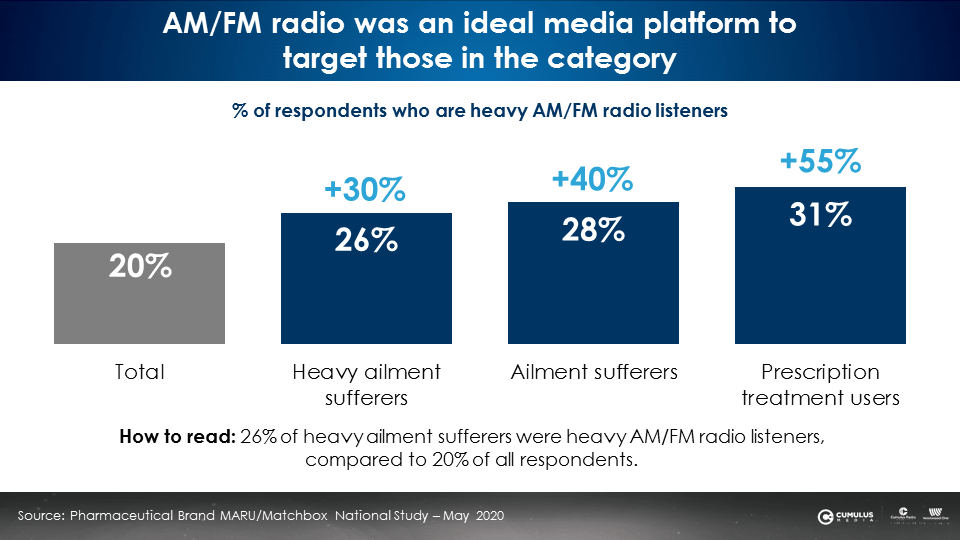
The more consumers listened to AM/FM radio, the more likely they were to be taking prescription medication for the ailment
58% of heavy AM/FM radio listeners said they were already taking prescription medication for the ailment, nearly twice that of light AM/FM radio listeners. More validation for using AM/FM radio to launch the brand.
Since AM/FM radio is the soundtrack of the American worker, it is possible that heavier AM/FM radio listeners are more likely to have health insurance through their company and more likely to take prescriptions to combat the ailment.
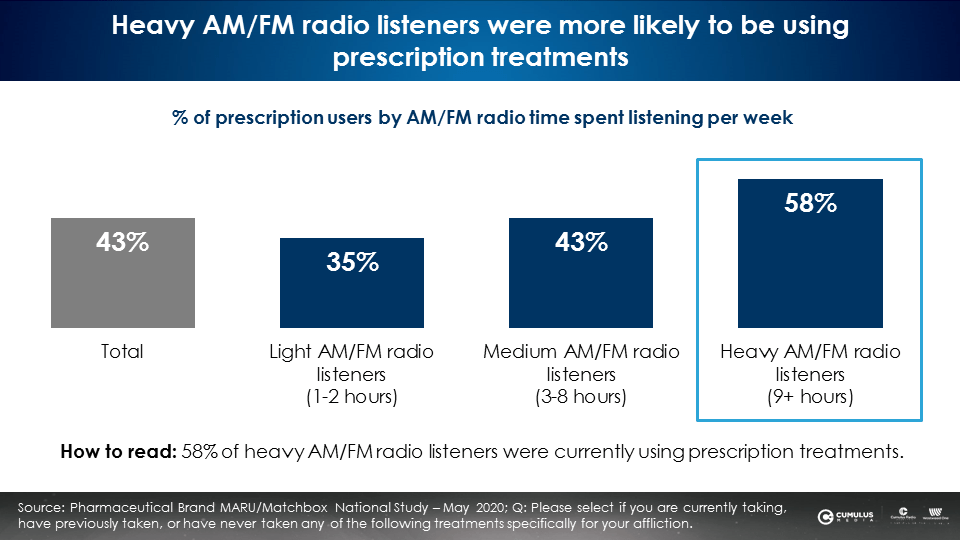
Heavy AM/FM radio listeners and heavy podcast listeners responded much more favorably to the AM/FM radio ads than heavy TV viewers
When exposed to the AM/FM radio ad, a majority of heavy AM/FM radio listeners and heavy podcast listeners said they found the ads to be likeable, relevant, memorable, and informative. Among heavy TV viewers, scores for these four measures were much lower.
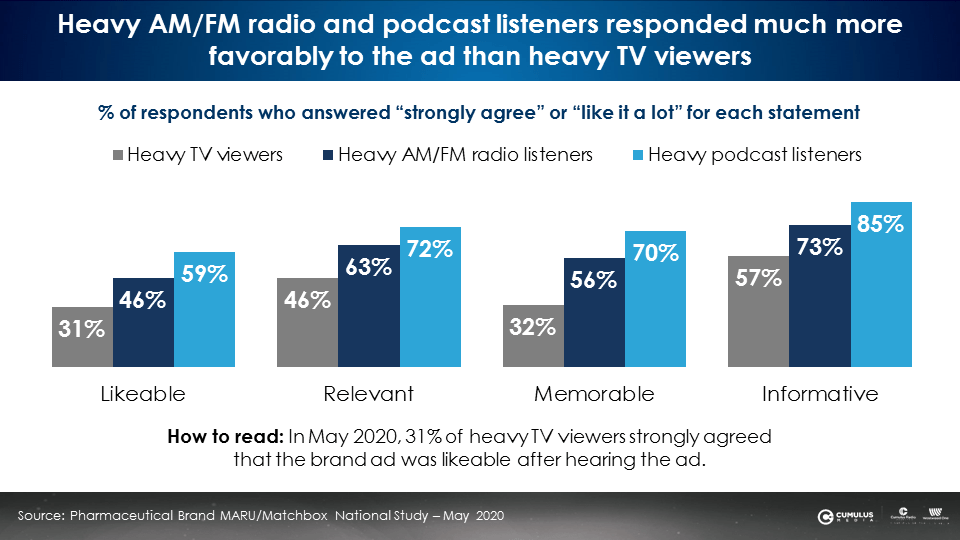
Heavy AM/FM radio listeners and heavy podcast listeners were more likely to take action after hearing the AM/FM radio ad
After hearing the AM/FM radio ad, the majority of heavy AM/FM radio listeners and heavy podcast listeners indicated they would take some sort of action such as searching online, speaking to a health care provider, or trying the brand. Nearly twice as many audio listeners said they would take action versus heavy TV viewers.
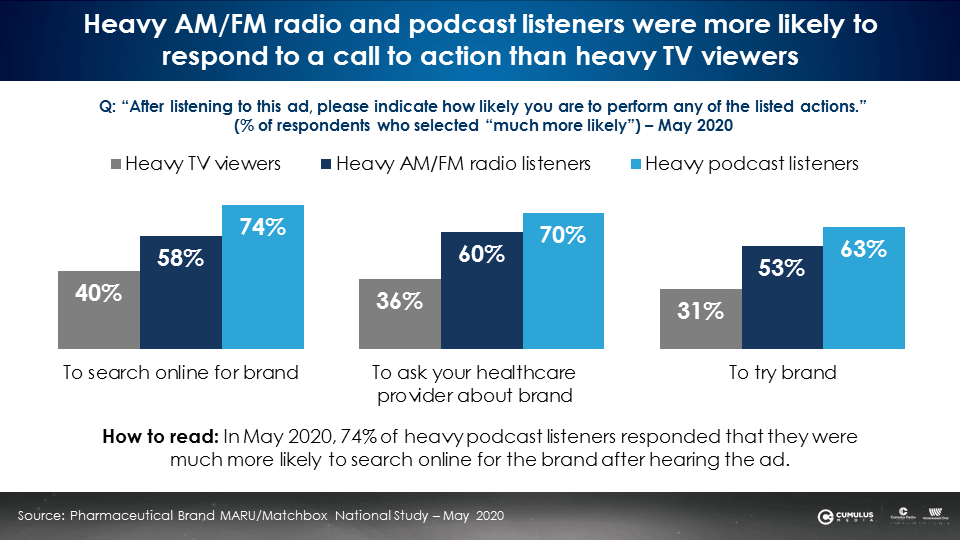
AM/FM radio boosted ad recall among those who suffered from the ailment and heavy AM/FM radio listeners
When exposed to the AM/FM radio ad, in just one month, there was a +31% increase in overall aided ad recall and a +58% increase among those who suffered from the ailment.
Most significantly, there was a +36% increase in aided ad recall among heavy AM/FM radio listeners between April and May. As heavy AM/FM radio listeners were more likely to hear the ad, this is a strong indication of the positive effect of the AM/FM radio campaign.
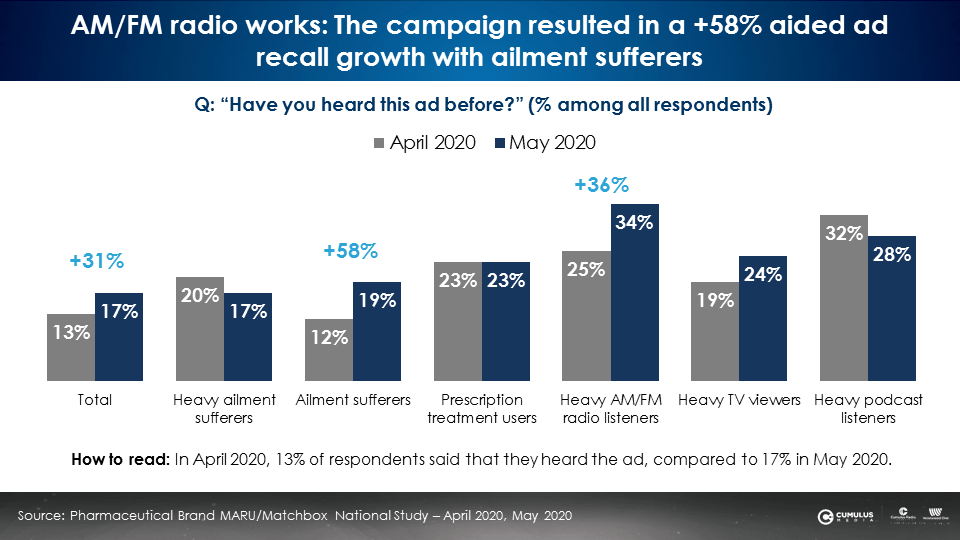
There was significant growth in consumers saying they would recommend the brand to friends and family after exposure
The net promoter score subtracts those who would not recommend a product, service, or retailer from those who would recommend. After hearing the AM/FM radio ad, the brand’s net promoter score among heavy AM/FM radio listeners grew from +9 in April 2020 to +39 in May 2020.
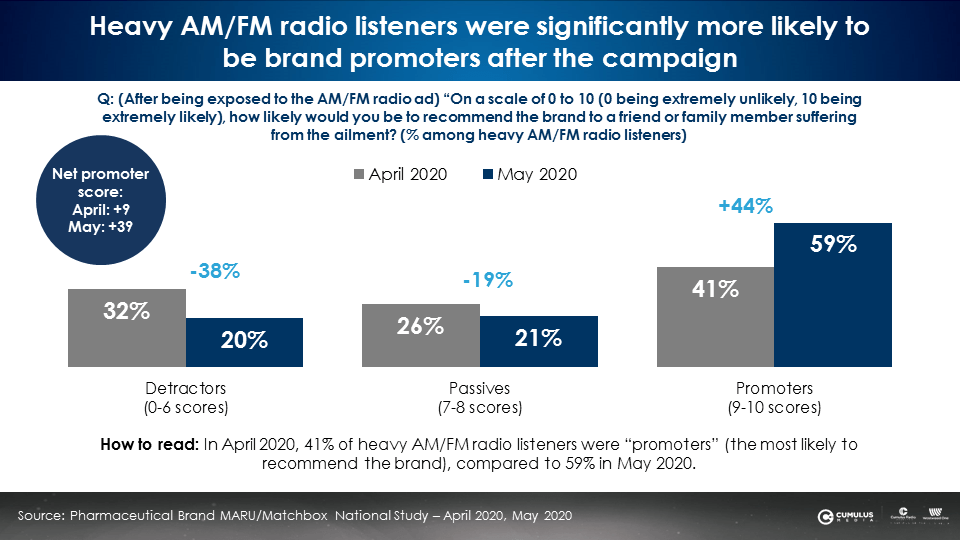
ABX: Pharmaceutical AM/FM radio ads test at 90% of the impact of TV ads for one-fifth the CPM
ABX, one of the leaders in creative testing, recently tested nine TV ads. Four were from a blockbuster rheumatoid/psoriatic arthritis drug and five were from a second pharmaceutical brand. ABX used the audio tracks from each TV ad and tested them as AM/FM radio ads. The four blockbuster rheumatoid/psoriatic arthritis drug AM/FM radio ads tested nearly the same as the TV ads using ABX’s rigorous creative evaluation.
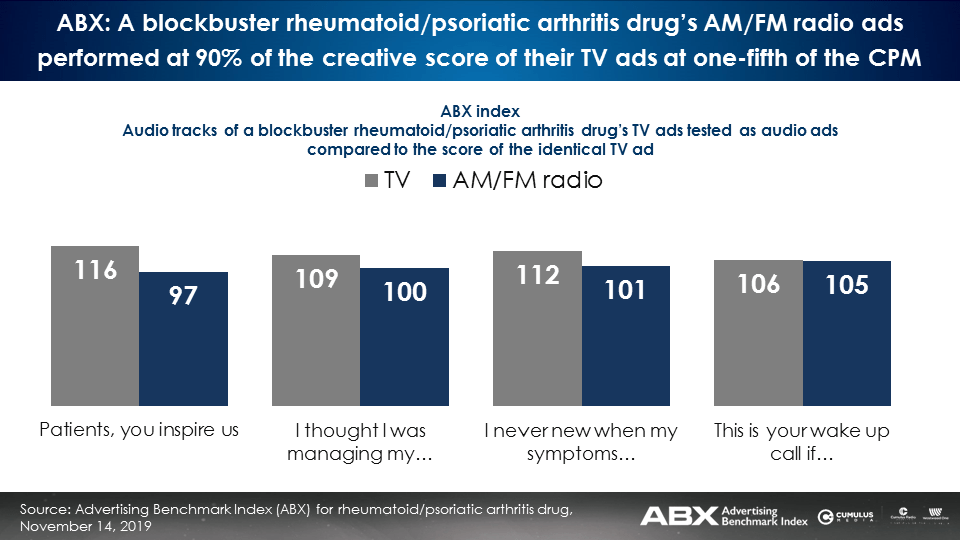
The five additional pharmaceutical AM/FM radio ads also tested almost as well as the TV ads.
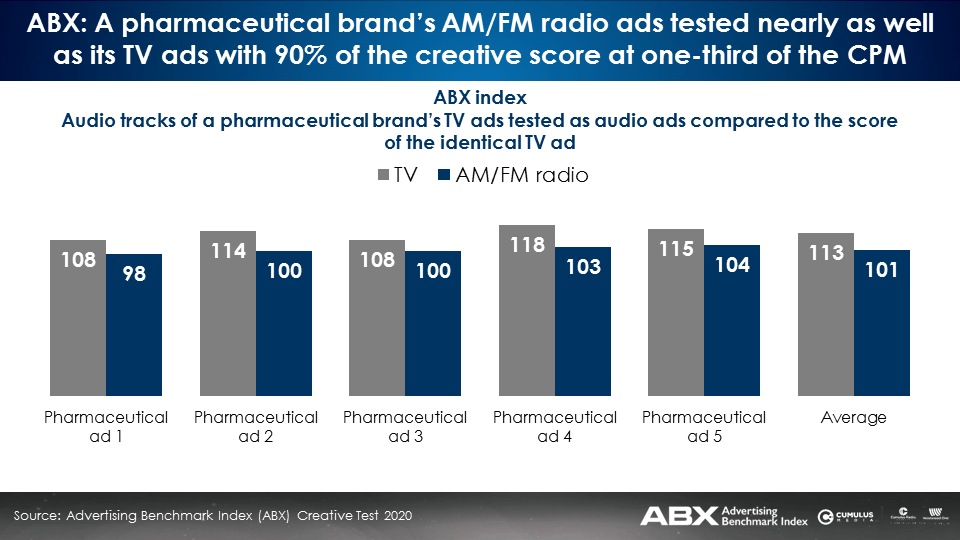
Gardening in slow motion: Audio does all the heavy lifting for pharmaceutical; TV visuals just fill time
The vast majority of pharmaceutical TV ads show people going about generic daily activities in slow motion. How many pharmaceutical ads have people gardening in slow motion? Dancing, hugging children, cooking, walking and aimlessly pointing into the distance – all in slow motion. The visual has nothing to do with the audio. The visual just fills the time.
Explaining the disease symptoms, how the medication can help, and all the side effects and risks associated falls to the audio. It is no wonder that AM/FM radio ads test just about as well as the TV ads. The only element missing from AM/FM radio ads is slow motion.
Nielsen Media Impact: The addition of AM/FM radio to any pharmaceutical TV campaign generates significant incremental reach
Two years ago, Nielsen enhanced Nielsen Media Impact, the industry-leading cross-platform media planning solution, to include national AM/FM radio and local Portable People Meter AM/FM radio markets. Nielsen Media Impact allows buyers and sellers to quantify the incremental reach achieved by including AM/FM radio in the media mix.
Here are three pharmaceutical TV campaigns of varying size. Nielsen Media Impact pulls in the TV ad occurrences and costs from Nielsen Ad Intel along with audience data from Nielsen’s TV audience panel and runs the monthly reach achieved.

Even with significant spend for each TV campaign, in each case, 30% to 45% of the U.S. was not reached:
- A blockbuster rheumatoid/psoriatic arthritis drug’s April TV campaign reached 70% of the U.S., missing 30% of the U.S.
- Eliquis reached 60% of the U.S. with their April TV campaign, leaving 40% unreached
- An irritable bowel syndrome drug achieved a 56% reach with TV for the month of April, missing 44% of the U.S.

Regardless of budget size, shifting 20% of the TV campaign to AM/FM radio would result in significant incremental reach growth for all three of the brands:
- The blockbuster rheumatoid/psoriatic arthritis drug’s 20% shift to AM/FM radio would add +33% additional reach
- Eliquis would experience a massive +42% reach growth with AM/FM radio in the plan
- The irritable bowel syndrome drug would see a +38% increase in incremental reach by shifting 20% of their TV dollars to AM/FM radio
Key takeaways:
- AM/FM radio was an ideal media channel for the new pharmaceutical brand
- The more consumers listened to AM/FM radio, the more likely they were to be ailment sufferers and taking prescription medication for it
- Heavy AM/FM radio listeners and heavy podcast listeners responded much more favorably to the AM/FM radio ads than heavy TV viewers
- Heavy AM/FM radio listeners and heavy podcast listeners were more likely to take action after hearing the AM/FM radio ad
- The campaign boosted ad recall among those who suffered from the ailment and heavy AM/FM radio listeners
- There was significant growth in consumers saying they would recommend the brand to friends and family after exposure
- ABX: Pharmaceutical AM/FM radio ads test at 90% of the impact of TV ads for one-fifth the CPM
- Gardening in slow motion: Audio does all the heavy lifting as pharmaceutical TV visuals just fill time
- Nielsen Media Impact: The addition of AM/FM radio to any pharmaceutical TV campaign generates significant incremental reach
Pierre Bouvard is Chief Insights Officer at CUMULUS MEDIA | Westwood One.
Contact the Insights team at CorpMarketing@westwoodone.com.